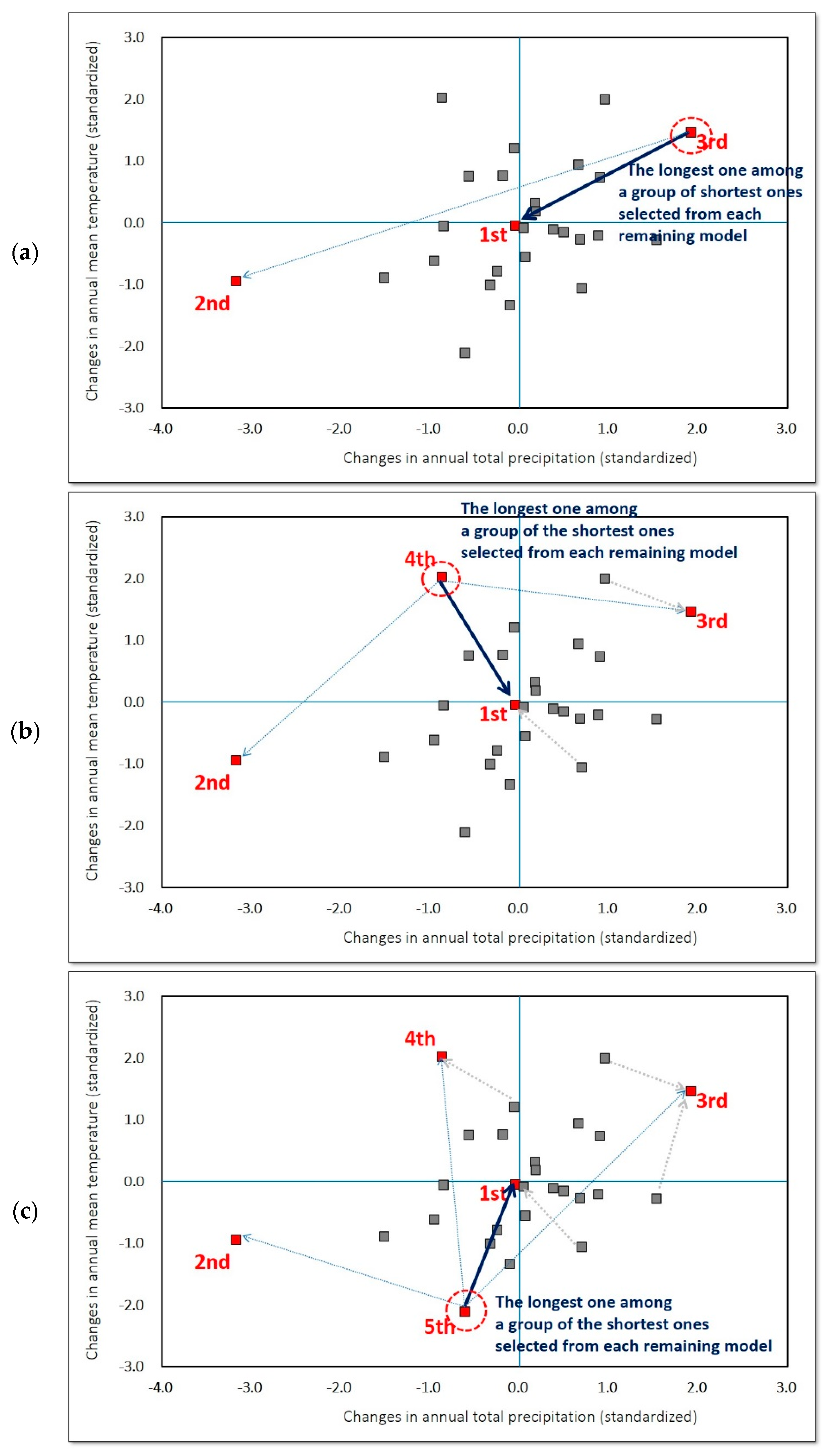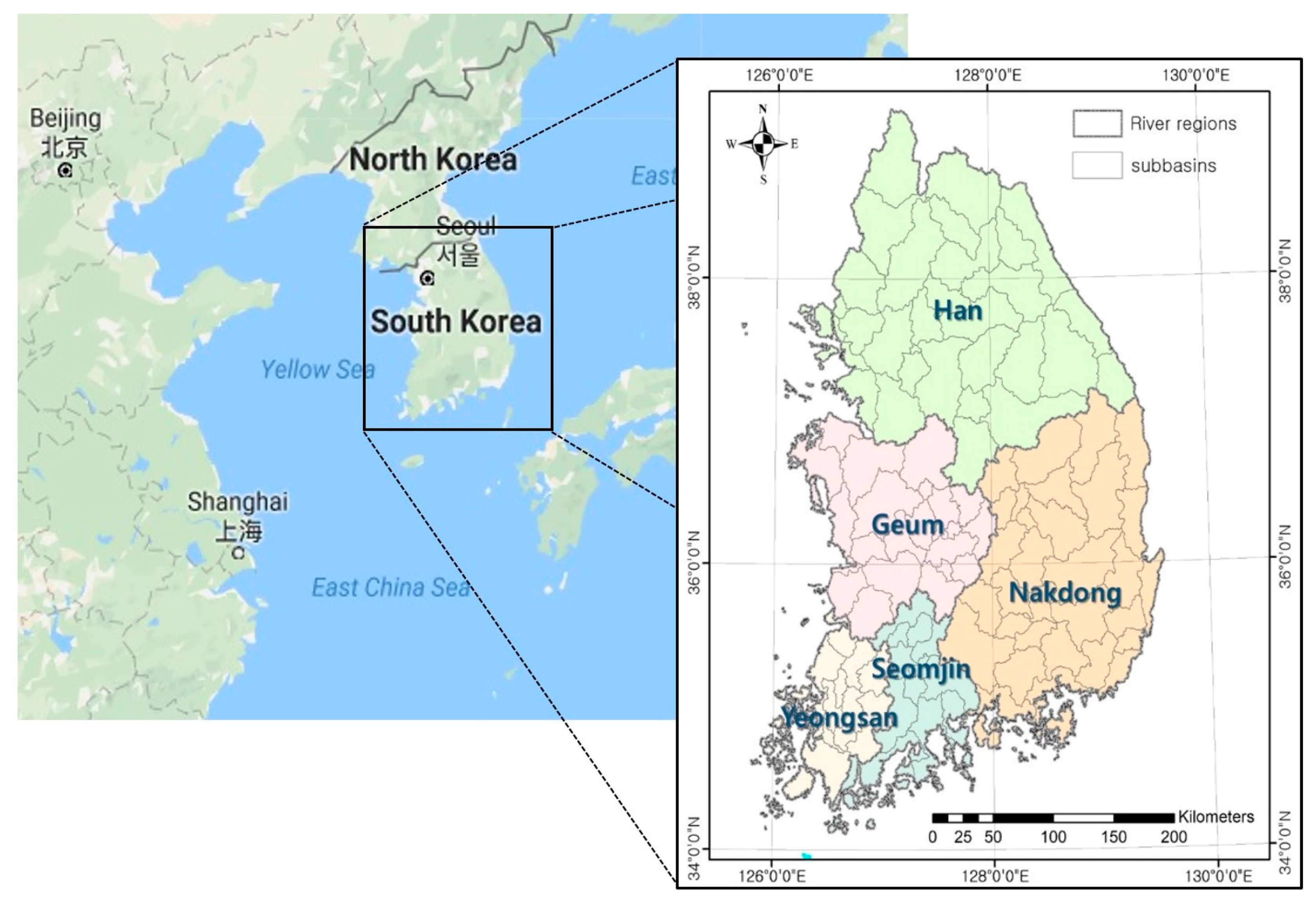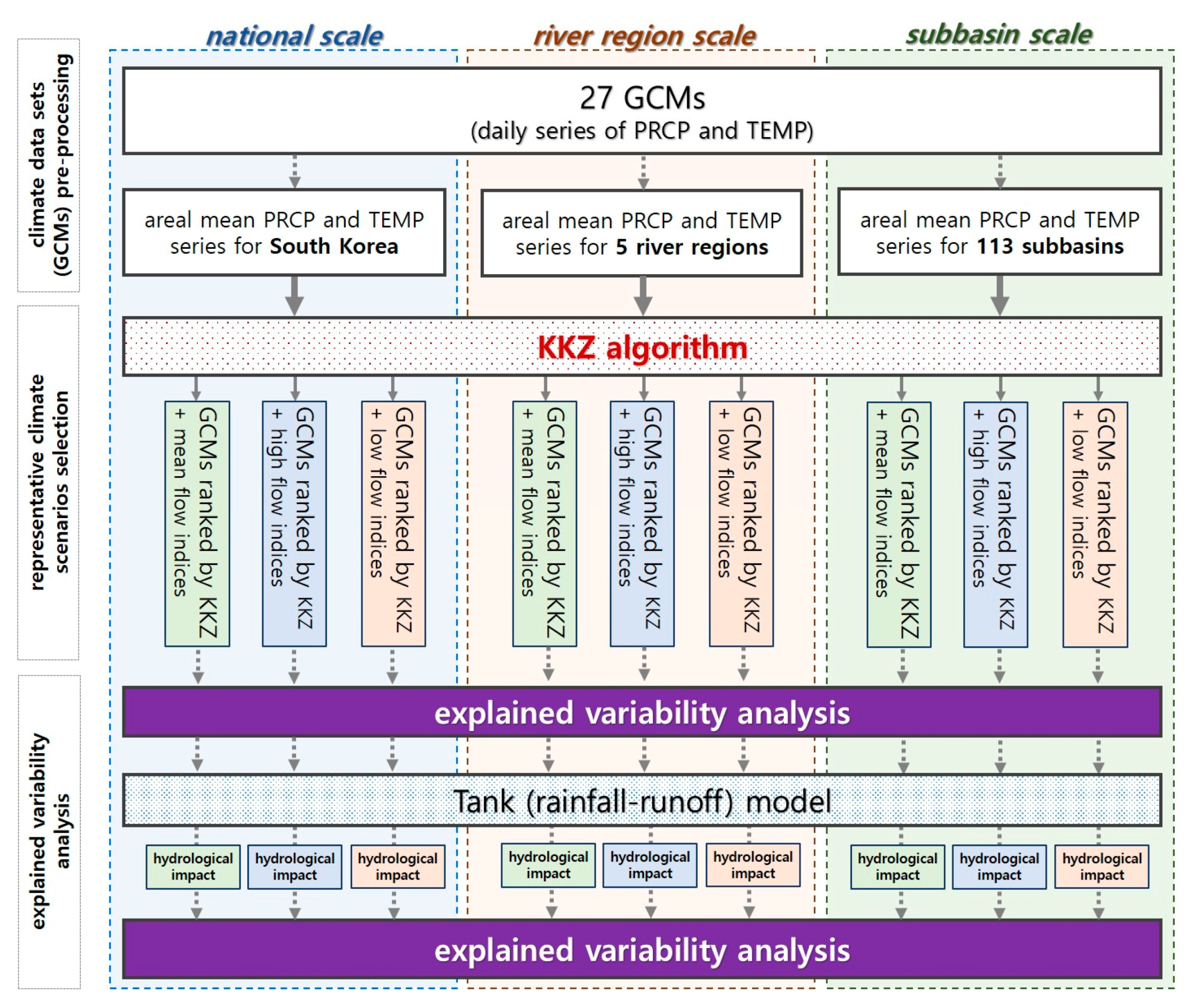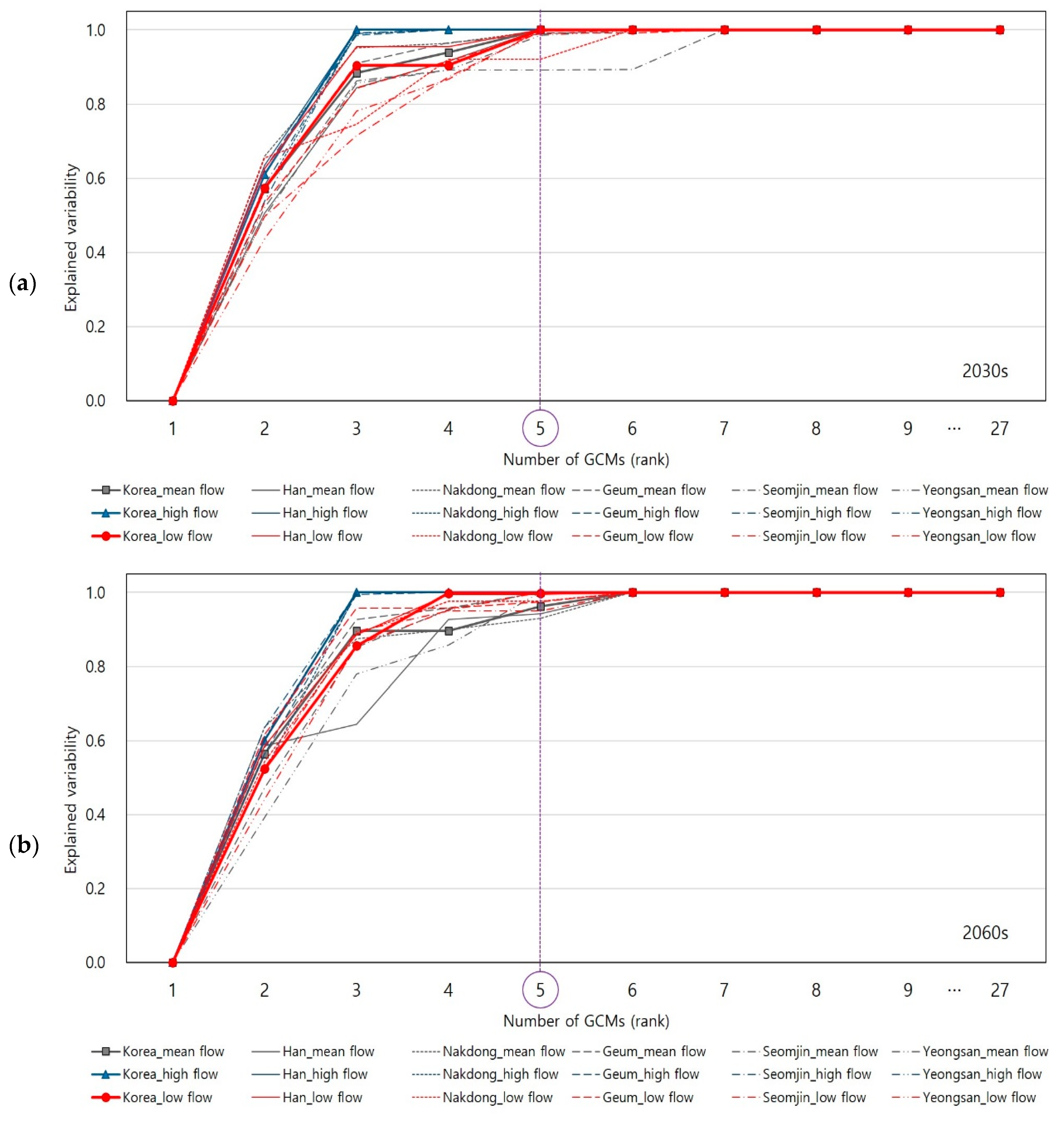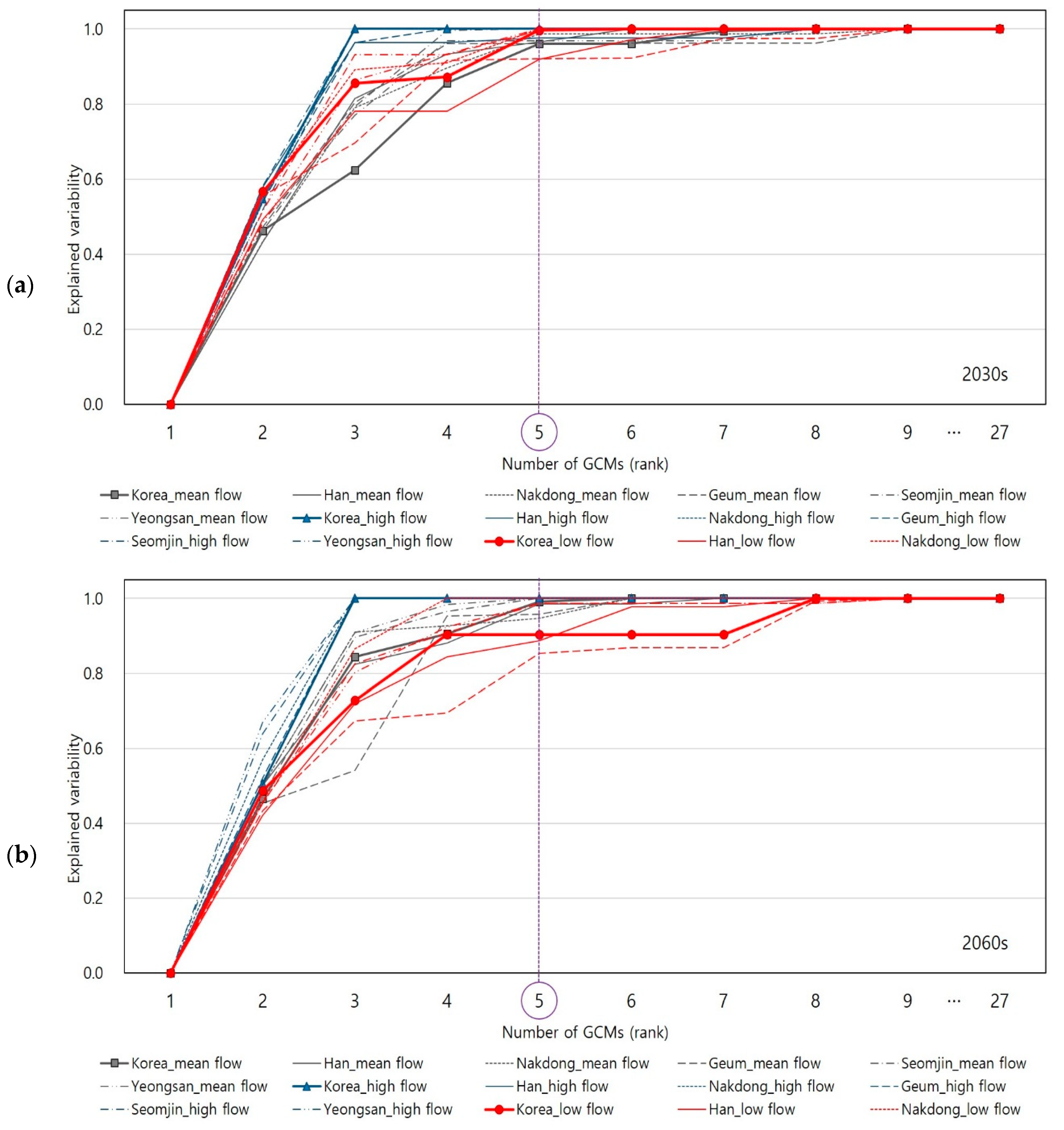1. Introduction
For sustainable management of water resources, future climate change impacts should be assessed for adaptive decision making. For climate change impact studies, projections driven by a group of Global Circulation Models (GCMs) are generally used to capture a plausible range of changes in future climate conditions. Although it is considered desirable to employ as many GCMs as possible to quantify the inter-model variability (i.e., the variability across all the GCMs outputs), this task can be complicated due to large computational costs [
1]. Further, decision-makers have difficulty in formulating a decision when they should consider a large number of climate change scenarios [
1]. In this regard, a variety of researchers have developed optimum techniques to select a subset of GCMs for climate change impact studies [
2,
3,
4,
5,
6,
7,
8]. In this paper, the term “GCMs” is used to synonymous with “climate change scenarios”.
According to the agreement of many experts, a subset of GCMs should achieve the following: (1) favor models that accurately reproduce patterns of historical climate (e.g., mean monthly values and annual cycles) [
9,
10], thus enhancing the plausibility of results for future projections in the target regions, and (2) incorporate a potential range of future climate conditions in terms of the key variables related to the climate change impact under investigation [
3,
4,
6,
7,
8,
11,
12]. However, it does not necessarily imply that the GCMs with the optimum performance will provide the most reliable climate projection [
1]. Many researchers have therefore focused on selecting techniques that can capture as an extensive range of inter-model variability in the future as possible while maintaining the number of GCMs at a minimum [
3,
4,
6,
7,
8,
12]. Further, several studies proposed selecting method that considers both the GCMs performance and the ability to capture inter-model variability [
1,
2,
5]. Nonetheless, since the worst-performing GCMs might underestimate inter-model variability, it still remains a matter of debate whether subsets from all available GCMs outputs should be selected [
1].
Majority of the previous studies have used clustering-based approaches such as
k-mean clustering [
3,
13] and hierarchical clustering [
6,
7,
8] for capturing inter-model variability. However, Cannon [
12] addressed the limitation of the clustering-based approaches and proposed the Katsavounidis–Kuo–Zhang (KKZ) algorithm [
14] for selecting a subset of GCMs that capture a range of variability in the 27 climate extremes indices. The KKZ algorithm selects members in a recursive manner that cover a spread of multivariate space comprehensively [
1,
12]. Cannon [
12] and Chen et al. [
15] demonstrated the superiority of the KKZ algorithm over the clustering-based approaches in terms of preserving the entire inter-model variability by a case study.
Nonetheless, there are a limited number of studies that evaluate the transferability of selected GCMs to uncertainty in hydrologic impacts studies such as streamflow. Chen et al. [
15] analyzed the capability of selected GCMs to preserve the uncertainty in regional hydrological projections using the KKZ algorithm. However, they did not consider climate extreme indices for selecting GCMs and address the dependency between optimal climate indices and the hydrologic variables. Seo et al. [
1] employed the KKZ algorithm to select a subset of GCMs based on climate extreme indices. Further, they discussed that key climate indices, which are dependent on the hydrologic extremes to be projected, must be determined prior to the selection of a subset of GCMs. Nonetheless, they have tested only a few target basins and not addressed potential impacts of different spatial scales of climate variables on the hydrologic variables.
Though it has been proved that the KKZ algorithm is a strong technique to select a subset of GCMs for handy climate change impact studies, there has been little efforts on selecting representative climate scenarios for national-level application. Since decision makers (e.g., government employees) and stakeholders have difficulties in making decisions pertaining to an ensemble of climate change scenarios, providing a subset of an ensemble (i.e., representative climate change scenarios) is practically beneficial for national-wide water resources planning. In this regard, this study aims at selecting national-level representative climate scenarios. On the other hand, since climate patterns can vary across all the regions, in-depth analysis on appropriate spatial aggregation level of climate variables for representative scenarios would be necessary. If a single set of spatially aggregated climate data is considered for selecting the climate scenarios for the entire country as like United States (US), spatial heterogeneity of climate pattern would be overlooked. For instance, in the US, it is common practice to have different models for different regions. On the other hand, if different sets of climate scenarios are required for each sub-region, it might lead huge confusion to decision makers especially in a small country, such as South Korea [
1,
3]. Many decision makers who are not specialized in climate or water resources field can be frustrated if they are advised to use different sets of climate scenarios for each region of interest. Hence, appropriate spatial aggregation level for representative scenarios also need to be analyzed in terms of various climate indicators.
Therefore, the objective of this study is to introduce a selection method for representative climate scenarios for national-level application. Furthermore, this study also evaluates appropriate spatial aggregation level for the representative climate scenarios for each group of climate indicators from a national-level case study.
The rest of this paper is organized as follows.
Section 2 describes theoretical background of key methods. In
Section 3, background for a national-level case study is provided along with the details of the proposed evaluation framework. In
Section 4, results of a case study are demonstrated as a form of selected climate scenarios and explained uncertainties in hydrologic variables. Finally, discussions and conclusions are presented in
Section 5, respectively.
5. Conclusions
Appropriate spatial scales for the selection of representative climate scenarios were analyzed in this study with a case study for South Korea. Overall, in case of such a small country like South Korea (approximately 0.1 million km
2), a single set of representative GCMs would be able to capture inter-model variabilities of hydrologic variables for local-level impact studies. However, for low flow variable, finer scale of GCMs selection would be required considering different sets for each local-level case studies. Furthermore, the representative GCMs need to be selected separately for different future periods since uncertainties in GCMs get larger with lead time, which is consistent with the previous study by Hawkins and Sutton [
47].
We found that the inter-model variabilities of changes in hydrologic variables are well preserved by only a single set of GCMs (i.e., the top five GCMs from the total 27 in this study). This can certainly reduce computational burden on water resources planning and management studies for which potential uncertainties in climate change should be addressed [
48]. However, for local-scale hydrologic impact studies (i.e., subbasin level in this study), decision makers may have difficulty in determining which set of GCMs they should use. If only a single set of GCMs is provided, they do not have to worry about which scenarios to use. On the contrary, different sets of GCMs are provided for each subbasin, which would hinder easy implementation of GCMs for local-scale studies.
Nonetheless, given that a single set of GCMs ranked by the national level selection has the remarkable ability to capture potential inter-model variabilities of changes in mean and high flow variables, the single set of representative climate scenarios can provide sufficient information on uncertainties in future changes in mean- and high-flow regimes. Only for low flow variables would a certain set of GCMs selected by finer spatial scale of climate data sets that are specified for local basins of interest be required for better understanding of uncertainties in future changes in the low flow regimes.
Furthermore, we found that different sets of GCMs were selected for the two different future periods (the 2030s and 2060s in this study). This implies that utilization of the same set of GCMs selected for near-term future would not be reliable for long-term future. Since relative importance of uncertainties in GCMs increases with time [
47], it seems reasonable that different sets of GCMs have to be selected for the near-term and long-term future period separately. In addition, different sets of GCMs were selected under two different RCP scenarios (4.5 and 8.5). This implies that different sets of representative GCMs can be selected according to what assumption on the future adaptation strategy would be considered.
We should note that the area of national-level application tested in this study, South Korea, is relatively small. When a national-level application is implemented on much wider nations, such as United States (USA), China, and Australia, spatial heterogeneity on climate data sets would diminish due to smoothing impact driven by averaging climate data sets on multiple locations. In these cases, sub-national level (e.g., states in USA) selection can be recommended for the selection of representative climate change scenarios.
